Consumer Behaviour & the Hospitality Sector: Accor Hotels Report
VerifiedAdded on 2023/06/06
|12
|4018
|251
Report
AI Summary
This report explores consumer behaviour and insights within the hospitality industry, focusing on Accor Hotels. It investigates cultural, social, personal, and psychological factors influencing consumer decisions, examines the impact of digital technology on consumer trends, and maps the consumer decision-making journey for hospitality services. The report also highlights the importance of understanding consumer decision-making for marketers in the hospitality sector, compares B2C and B2B decision-making processes, evaluates different market research approaches, and assesses how marketers can influence various stages of the hospitality decision-making process with specific examples. The study concludes by emphasizing the crucial role of consumer behavior analysis in shaping successful marketing strategies for hospitality businesses like Accor.
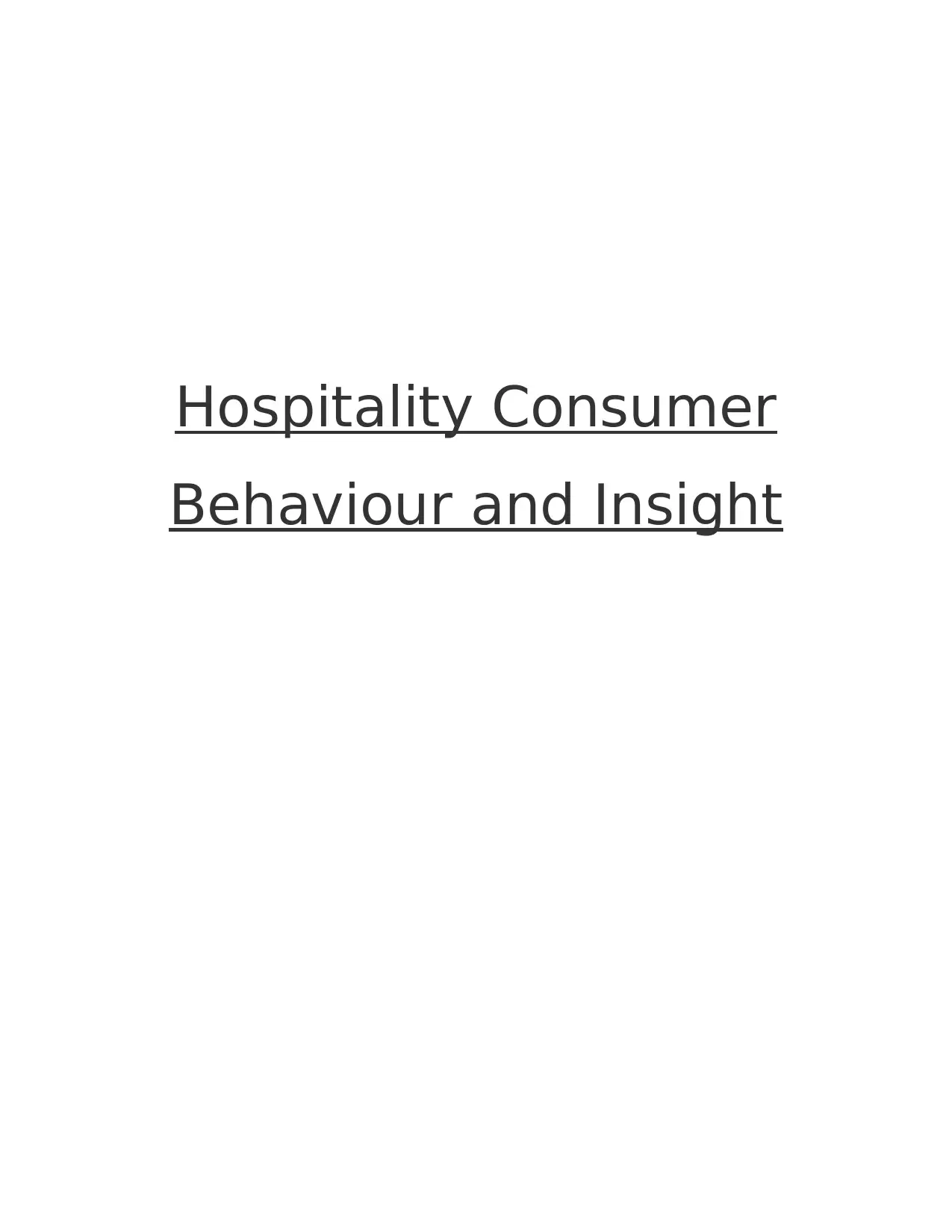
Hospitality Consumer
Behaviour and Insight
Behaviour and Insight
Paraphrase This Document
Need a fresh take? Get an instant paraphrase of this document with our AI Paraphraser
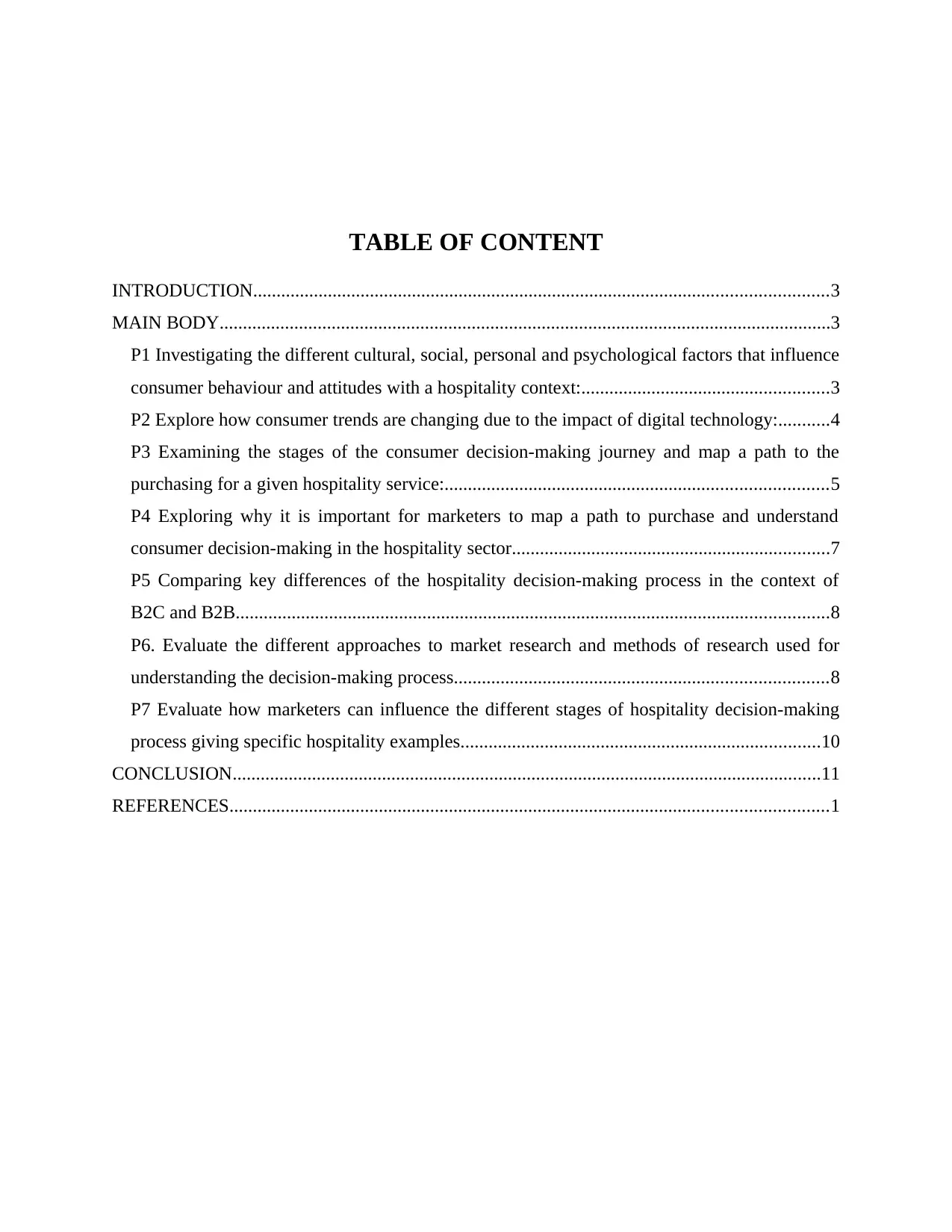
TABLE OF CONTENT
INTRODUCTION...........................................................................................................................3
MAIN BODY...................................................................................................................................3
P1 Investigating the different cultural, social, personal and psychological factors that influence
consumer behaviour and attitudes with a hospitality context:.....................................................3
P2 Explore how consumer trends are changing due to the impact of digital technology:...........4
P3 Examining the stages of the consumer decision-making journey and map a path to the
purchasing for a given hospitality service:..................................................................................5
P4 Exploring why it is important for marketers to map a path to purchase and understand
consumer decision-making in the hospitality sector....................................................................7
P5 Comparing key differences of the hospitality decision-making process in the context of
B2C and B2B...............................................................................................................................8
P6. Evaluate the different approaches to market research and methods of research used for
understanding the decision-making process................................................................................8
P7 Evaluate how marketers can influence the different stages of hospitality decision-making
process giving specific hospitality examples.............................................................................10
CONCLUSION..............................................................................................................................11
REFERENCES................................................................................................................................1
INTRODUCTION...........................................................................................................................3
MAIN BODY...................................................................................................................................3
P1 Investigating the different cultural, social, personal and psychological factors that influence
consumer behaviour and attitudes with a hospitality context:.....................................................3
P2 Explore how consumer trends are changing due to the impact of digital technology:...........4
P3 Examining the stages of the consumer decision-making journey and map a path to the
purchasing for a given hospitality service:..................................................................................5
P4 Exploring why it is important for marketers to map a path to purchase and understand
consumer decision-making in the hospitality sector....................................................................7
P5 Comparing key differences of the hospitality decision-making process in the context of
B2C and B2B...............................................................................................................................8
P6. Evaluate the different approaches to market research and methods of research used for
understanding the decision-making process................................................................................8
P7 Evaluate how marketers can influence the different stages of hospitality decision-making
process giving specific hospitality examples.............................................................................10
CONCLUSION..............................................................................................................................11
REFERENCES................................................................................................................................1
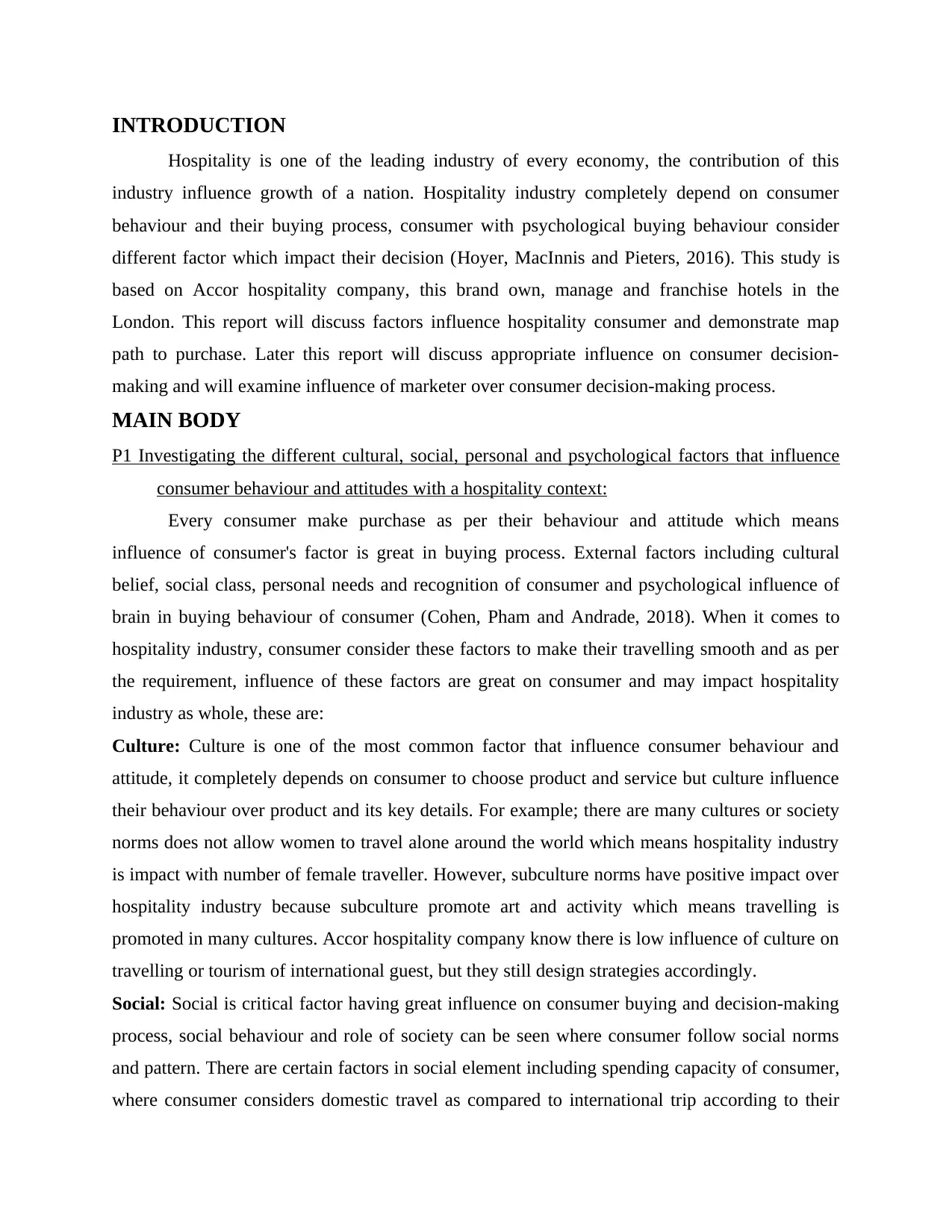
INTRODUCTION
Hospitality is one of the leading industry of every economy, the contribution of this
industry influence growth of a nation. Hospitality industry completely depend on consumer
behaviour and their buying process, consumer with psychological buying behaviour consider
different factor which impact their decision (Hoyer, MacInnis and Pieters, 2016). This study is
based on Accor hospitality company, this brand own, manage and franchise hotels in the
London. This report will discuss factors influence hospitality consumer and demonstrate map
path to purchase. Later this report will discuss appropriate influence on consumer decision-
making and will examine influence of marketer over consumer decision-making process.
MAIN BODY
P1 Investigating the different cultural, social, personal and psychological factors that influence
consumer behaviour and attitudes with a hospitality context:
Every consumer make purchase as per their behaviour and attitude which means
influence of consumer's factor is great in buying process. External factors including cultural
belief, social class, personal needs and recognition of consumer and psychological influence of
brain in buying behaviour of consumer (Cohen, Pham and Andrade, 2018). When it comes to
hospitality industry, consumer consider these factors to make their travelling smooth and as per
the requirement, influence of these factors are great on consumer and may impact hospitality
industry as whole, these are:
Culture: Culture is one of the most common factor that influence consumer behaviour and
attitude, it completely depends on consumer to choose product and service but culture influence
their behaviour over product and its key details. For example; there are many cultures or society
norms does not allow women to travel alone around the world which means hospitality industry
is impact with number of female traveller. However, subculture norms have positive impact over
hospitality industry because subculture promote art and activity which means travelling is
promoted in many cultures. Accor hospitality company know there is low influence of culture on
travelling or tourism of international guest, but they still design strategies accordingly.
Social: Social is critical factor having great influence on consumer buying and decision-making
process, social behaviour and role of society can be seen where consumer follow social norms
and pattern. There are certain factors in social element including spending capacity of consumer,
where consumer considers domestic travel as compared to international trip according to their
Hospitality is one of the leading industry of every economy, the contribution of this
industry influence growth of a nation. Hospitality industry completely depend on consumer
behaviour and their buying process, consumer with psychological buying behaviour consider
different factor which impact their decision (Hoyer, MacInnis and Pieters, 2016). This study is
based on Accor hospitality company, this brand own, manage and franchise hotels in the
London. This report will discuss factors influence hospitality consumer and demonstrate map
path to purchase. Later this report will discuss appropriate influence on consumer decision-
making and will examine influence of marketer over consumer decision-making process.
MAIN BODY
P1 Investigating the different cultural, social, personal and psychological factors that influence
consumer behaviour and attitudes with a hospitality context:
Every consumer make purchase as per their behaviour and attitude which means
influence of consumer's factor is great in buying process. External factors including cultural
belief, social class, personal needs and recognition of consumer and psychological influence of
brain in buying behaviour of consumer (Cohen, Pham and Andrade, 2018). When it comes to
hospitality industry, consumer consider these factors to make their travelling smooth and as per
the requirement, influence of these factors are great on consumer and may impact hospitality
industry as whole, these are:
Culture: Culture is one of the most common factor that influence consumer behaviour and
attitude, it completely depends on consumer to choose product and service but culture influence
their behaviour over product and its key details. For example; there are many cultures or society
norms does not allow women to travel alone around the world which means hospitality industry
is impact with number of female traveller. However, subculture norms have positive impact over
hospitality industry because subculture promote art and activity which means travelling is
promoted in many cultures. Accor hospitality company know there is low influence of culture on
travelling or tourism of international guest, but they still design strategies accordingly.
Social: Social is critical factor having great influence on consumer buying and decision-making
process, social behaviour and role of society can be seen where consumer follow social norms
and pattern. There are certain factors in social element including spending capacity of consumer,
where consumer considers domestic travel as compared to international trip according to their
⊘ This is a preview!⊘
Do you want full access?
Subscribe today to unlock all pages.

Trusted by 1+ million students worldwide
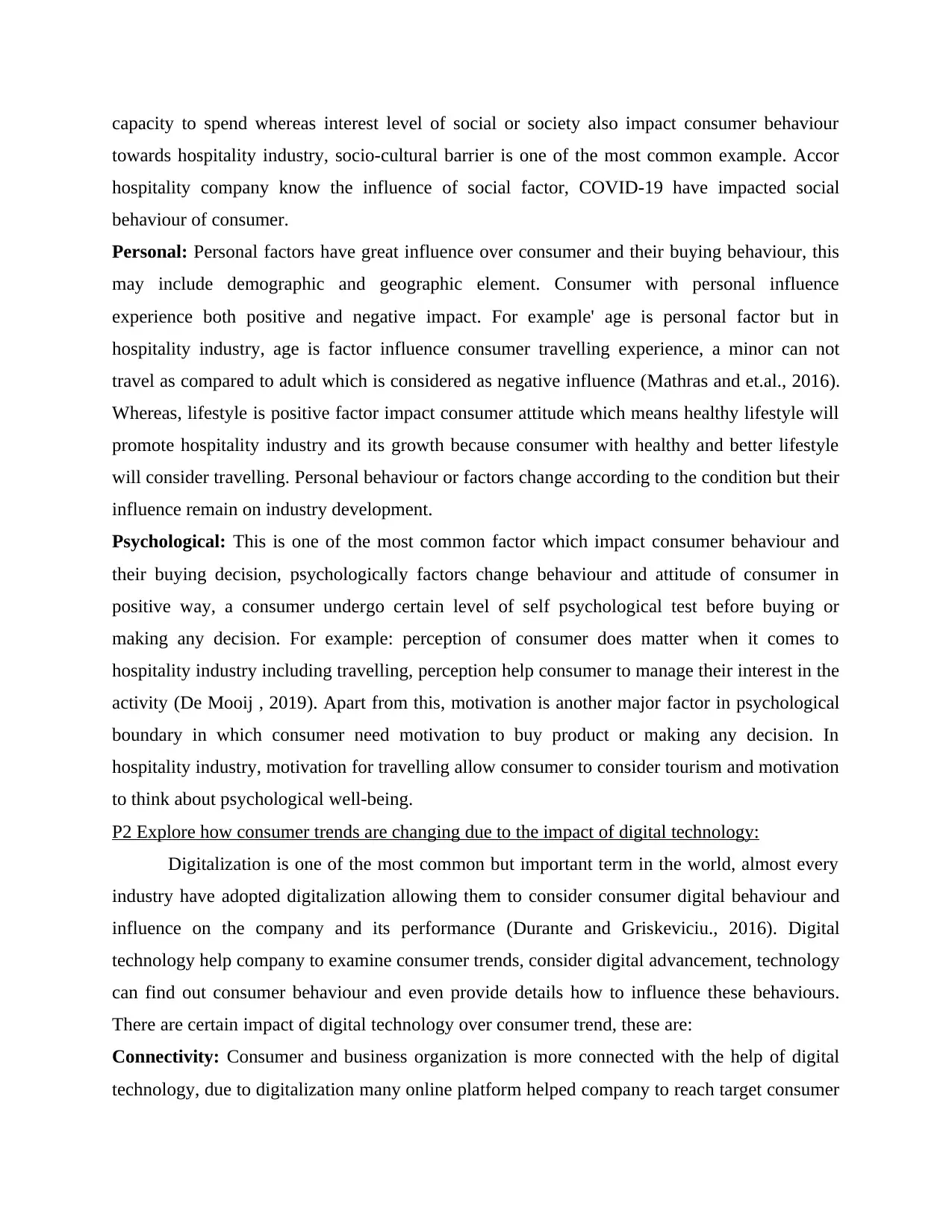
capacity to spend whereas interest level of social or society also impact consumer behaviour
towards hospitality industry, socio-cultural barrier is one of the most common example. Accor
hospitality company know the influence of social factor, COVID-19 have impacted social
behaviour of consumer.
Personal: Personal factors have great influence over consumer and their buying behaviour, this
may include demographic and geographic element. Consumer with personal influence
experience both positive and negative impact. For example' age is personal factor but in
hospitality industry, age is factor influence consumer travelling experience, a minor can not
travel as compared to adult which is considered as negative influence (Mathras and et.al., 2016).
Whereas, lifestyle is positive factor impact consumer attitude which means healthy lifestyle will
promote hospitality industry and its growth because consumer with healthy and better lifestyle
will consider travelling. Personal behaviour or factors change according to the condition but their
influence remain on industry development.
Psychological: This is one of the most common factor which impact consumer behaviour and
their buying decision, psychologically factors change behaviour and attitude of consumer in
positive way, a consumer undergo certain level of self psychological test before buying or
making any decision. For example: perception of consumer does matter when it comes to
hospitality industry including travelling, perception help consumer to manage their interest in the
activity (De Mooij , 2019). Apart from this, motivation is another major factor in psychological
boundary in which consumer need motivation to buy product or making any decision. In
hospitality industry, motivation for travelling allow consumer to consider tourism and motivation
to think about psychological well-being.
P2 Explore how consumer trends are changing due to the impact of digital technology:
Digitalization is one of the most common but important term in the world, almost every
industry have adopted digitalization allowing them to consider consumer digital behaviour and
influence on the company and its performance (Durante and Griskeviciu., 2016). Digital
technology help company to examine consumer trends, consider digital advancement, technology
can find out consumer behaviour and even provide details how to influence these behaviours.
There are certain impact of digital technology over consumer trend, these are:
Connectivity: Consumer and business organization is more connected with the help of digital
technology, due to digitalization many online platform helped company to reach target consumer
towards hospitality industry, socio-cultural barrier is one of the most common example. Accor
hospitality company know the influence of social factor, COVID-19 have impacted social
behaviour of consumer.
Personal: Personal factors have great influence over consumer and their buying behaviour, this
may include demographic and geographic element. Consumer with personal influence
experience both positive and negative impact. For example' age is personal factor but in
hospitality industry, age is factor influence consumer travelling experience, a minor can not
travel as compared to adult which is considered as negative influence (Mathras and et.al., 2016).
Whereas, lifestyle is positive factor impact consumer attitude which means healthy lifestyle will
promote hospitality industry and its growth because consumer with healthy and better lifestyle
will consider travelling. Personal behaviour or factors change according to the condition but their
influence remain on industry development.
Psychological: This is one of the most common factor which impact consumer behaviour and
their buying decision, psychologically factors change behaviour and attitude of consumer in
positive way, a consumer undergo certain level of self psychological test before buying or
making any decision. For example: perception of consumer does matter when it comes to
hospitality industry including travelling, perception help consumer to manage their interest in the
activity (De Mooij , 2019). Apart from this, motivation is another major factor in psychological
boundary in which consumer need motivation to buy product or making any decision. In
hospitality industry, motivation for travelling allow consumer to consider tourism and motivation
to think about psychological well-being.
P2 Explore how consumer trends are changing due to the impact of digital technology:
Digitalization is one of the most common but important term in the world, almost every
industry have adopted digitalization allowing them to consider consumer digital behaviour and
influence on the company and its performance (Durante and Griskeviciu., 2016). Digital
technology help company to examine consumer trends, consider digital advancement, technology
can find out consumer behaviour and even provide details how to influence these behaviours.
There are certain impact of digital technology over consumer trend, these are:
Connectivity: Consumer and business organization is more connected with the help of digital
technology, due to digitalization many online platform helped company to reach target consumer
Paraphrase This Document
Need a fresh take? Get an instant paraphrase of this document with our AI Paraphraser
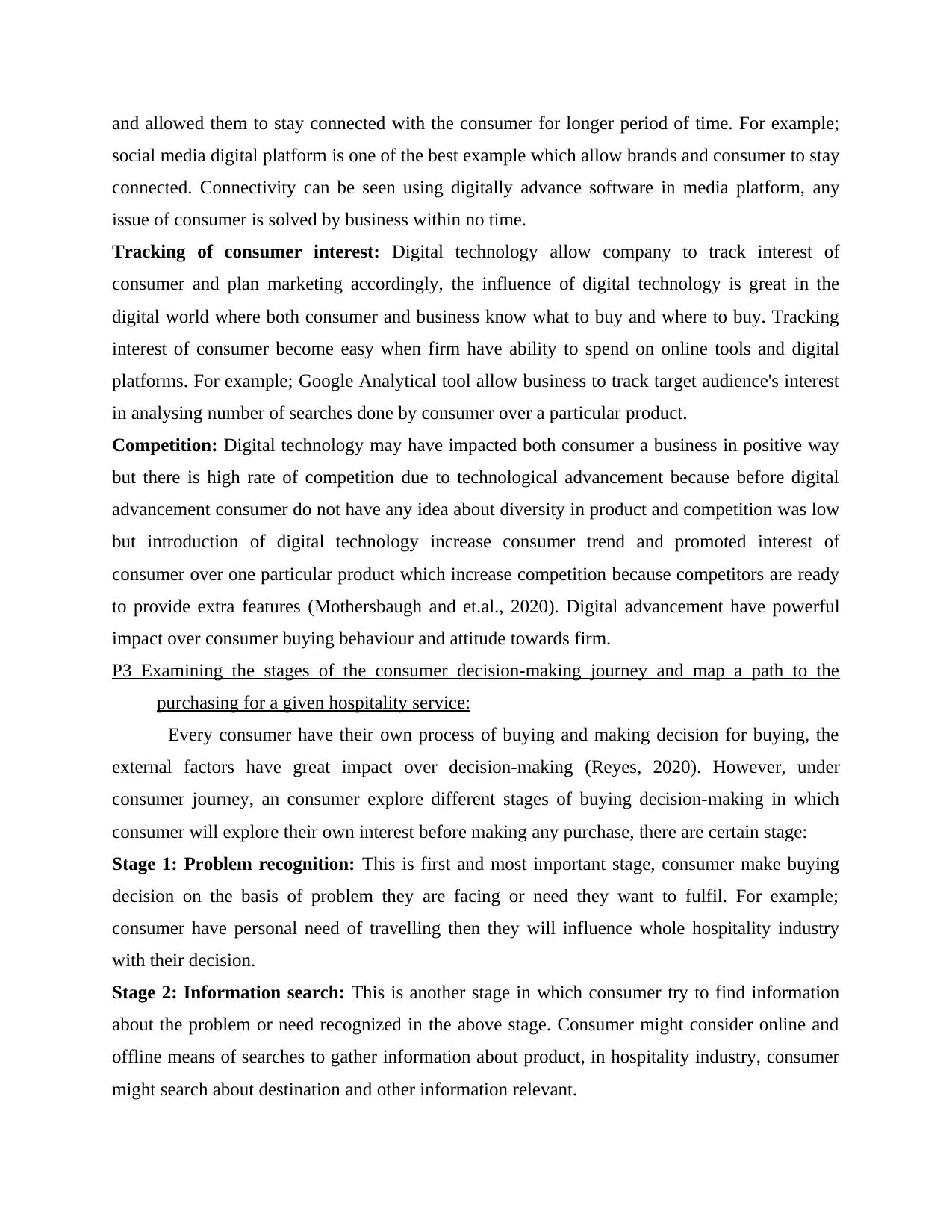
and allowed them to stay connected with the consumer for longer period of time. For example;
social media digital platform is one of the best example which allow brands and consumer to stay
connected. Connectivity can be seen using digitally advance software in media platform, any
issue of consumer is solved by business within no time.
Tracking of consumer interest: Digital technology allow company to track interest of
consumer and plan marketing accordingly, the influence of digital technology is great in the
digital world where both consumer and business know what to buy and where to buy. Tracking
interest of consumer become easy when firm have ability to spend on online tools and digital
platforms. For example; Google Analytical tool allow business to track target audience's interest
in analysing number of searches done by consumer over a particular product.
Competition: Digital technology may have impacted both consumer a business in positive way
but there is high rate of competition due to technological advancement because before digital
advancement consumer do not have any idea about diversity in product and competition was low
but introduction of digital technology increase consumer trend and promoted interest of
consumer over one particular product which increase competition because competitors are ready
to provide extra features (Mothersbaugh and et.al., 2020). Digital advancement have powerful
impact over consumer buying behaviour and attitude towards firm.
P3 Examining the stages of the consumer decision-making journey and map a path to the
purchasing for a given hospitality service:
Every consumer have their own process of buying and making decision for buying, the
external factors have great impact over decision-making (Reyes, 2020). However, under
consumer journey, an consumer explore different stages of buying decision-making in which
consumer will explore their own interest before making any purchase, there are certain stage:
Stage 1: Problem recognition: This is first and most important stage, consumer make buying
decision on the basis of problem they are facing or need they want to fulfil. For example;
consumer have personal need of travelling then they will influence whole hospitality industry
with their decision.
Stage 2: Information search: This is another stage in which consumer try to find information
about the problem or need recognized in the above stage. Consumer might consider online and
offline means of searches to gather information about product, in hospitality industry, consumer
might search about destination and other information relevant.
social media digital platform is one of the best example which allow brands and consumer to stay
connected. Connectivity can be seen using digitally advance software in media platform, any
issue of consumer is solved by business within no time.
Tracking of consumer interest: Digital technology allow company to track interest of
consumer and plan marketing accordingly, the influence of digital technology is great in the
digital world where both consumer and business know what to buy and where to buy. Tracking
interest of consumer become easy when firm have ability to spend on online tools and digital
platforms. For example; Google Analytical tool allow business to track target audience's interest
in analysing number of searches done by consumer over a particular product.
Competition: Digital technology may have impacted both consumer a business in positive way
but there is high rate of competition due to technological advancement because before digital
advancement consumer do not have any idea about diversity in product and competition was low
but introduction of digital technology increase consumer trend and promoted interest of
consumer over one particular product which increase competition because competitors are ready
to provide extra features (Mothersbaugh and et.al., 2020). Digital advancement have powerful
impact over consumer buying behaviour and attitude towards firm.
P3 Examining the stages of the consumer decision-making journey and map a path to the
purchasing for a given hospitality service:
Every consumer have their own process of buying and making decision for buying, the
external factors have great impact over decision-making (Reyes, 2020). However, under
consumer journey, an consumer explore different stages of buying decision-making in which
consumer will explore their own interest before making any purchase, there are certain stage:
Stage 1: Problem recognition: This is first and most important stage, consumer make buying
decision on the basis of problem they are facing or need they want to fulfil. For example;
consumer have personal need of travelling then they will influence whole hospitality industry
with their decision.
Stage 2: Information search: This is another stage in which consumer try to find information
about the problem or need recognized in the above stage. Consumer might consider online and
offline means of searches to gather information about product, in hospitality industry, consumer
might search about destination and other information relevant.
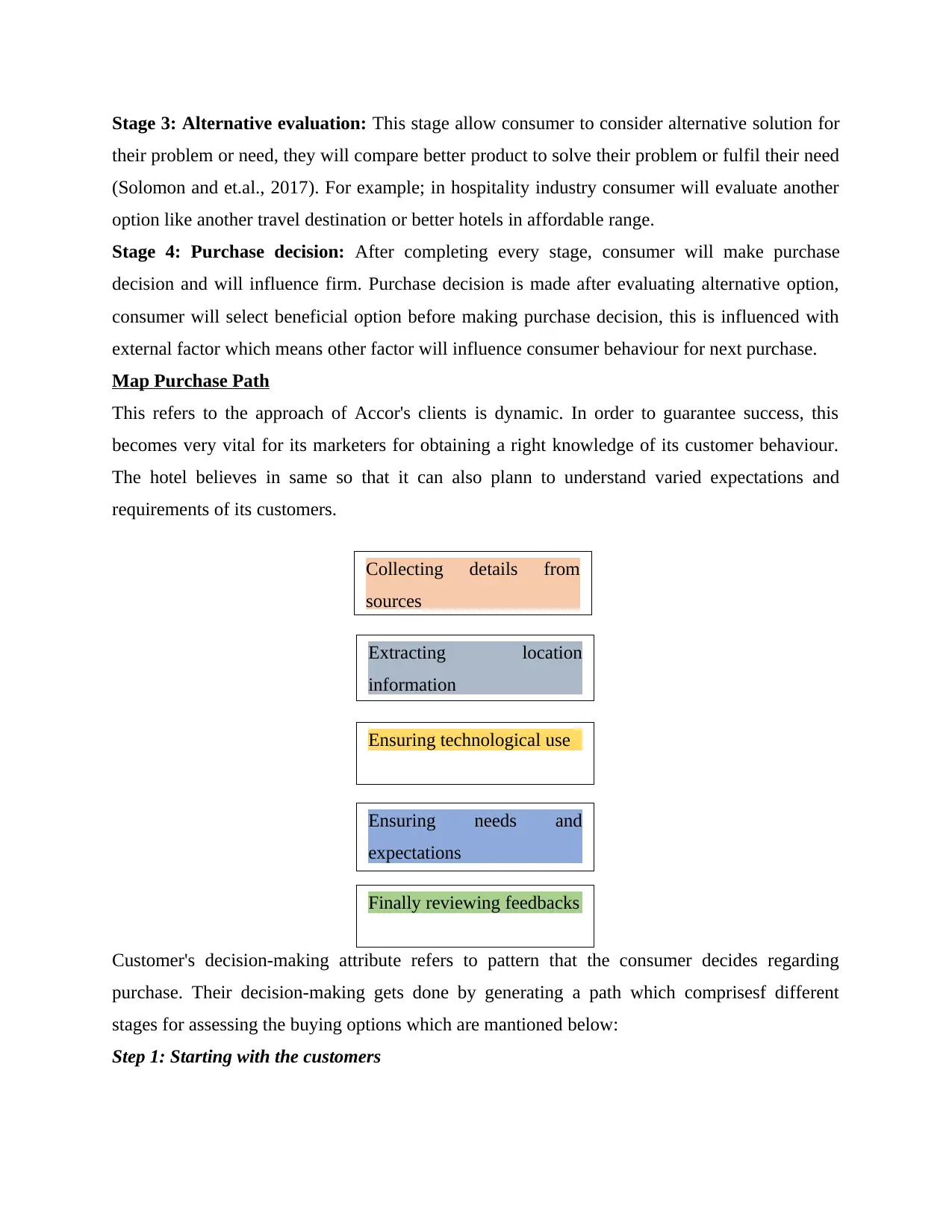
Stage 3: Alternative evaluation: This stage allow consumer to consider alternative solution for
their problem or need, they will compare better product to solve their problem or fulfil their need
(Solomon and et.al., 2017). For example; in hospitality industry consumer will evaluate another
option like another travel destination or better hotels in affordable range.
Stage 4: Purchase decision: After completing every stage, consumer will make purchase
decision and will influence firm. Purchase decision is made after evaluating alternative option,
consumer will select beneficial option before making purchase decision, this is influenced with
external factor which means other factor will influence consumer behaviour for next purchase.
Map Purchase Path
This refers to the approach of Accor's clients is dynamic. In order to guarantee success, this
becomes very vital for its marketers for obtaining a right knowledge of its customer behaviour.
The hotel believes in same so that it can also plann to understand varied expectations and
requirements of its customers.
Customer's decision-making attribute refers to pattern that the consumer decides regarding
purchase. Their decision-making gets done by generating a path which comprisesf different
stages for assessing the buying options which are mantioned below:
Step 1: Starting with the customers
Collecting details from
sources
Extracting location
information
Ensuring needs and
expectations
Finally reviewing feedbacks
Ensuring technological use
their problem or need, they will compare better product to solve their problem or fulfil their need
(Solomon and et.al., 2017). For example; in hospitality industry consumer will evaluate another
option like another travel destination or better hotels in affordable range.
Stage 4: Purchase decision: After completing every stage, consumer will make purchase
decision and will influence firm. Purchase decision is made after evaluating alternative option,
consumer will select beneficial option before making purchase decision, this is influenced with
external factor which means other factor will influence consumer behaviour for next purchase.
Map Purchase Path
This refers to the approach of Accor's clients is dynamic. In order to guarantee success, this
becomes very vital for its marketers for obtaining a right knowledge of its customer behaviour.
The hotel believes in same so that it can also plann to understand varied expectations and
requirements of its customers.
Customer's decision-making attribute refers to pattern that the consumer decides regarding
purchase. Their decision-making gets done by generating a path which comprisesf different
stages for assessing the buying options which are mantioned below:
Step 1: Starting with the customers
Collecting details from
sources
Extracting location
information
Ensuring needs and
expectations
Finally reviewing feedbacks
Ensuring technological use
⊘ This is a preview!⊘
Do you want full access?
Subscribe today to unlock all pages.

Trusted by 1+ million students worldwide
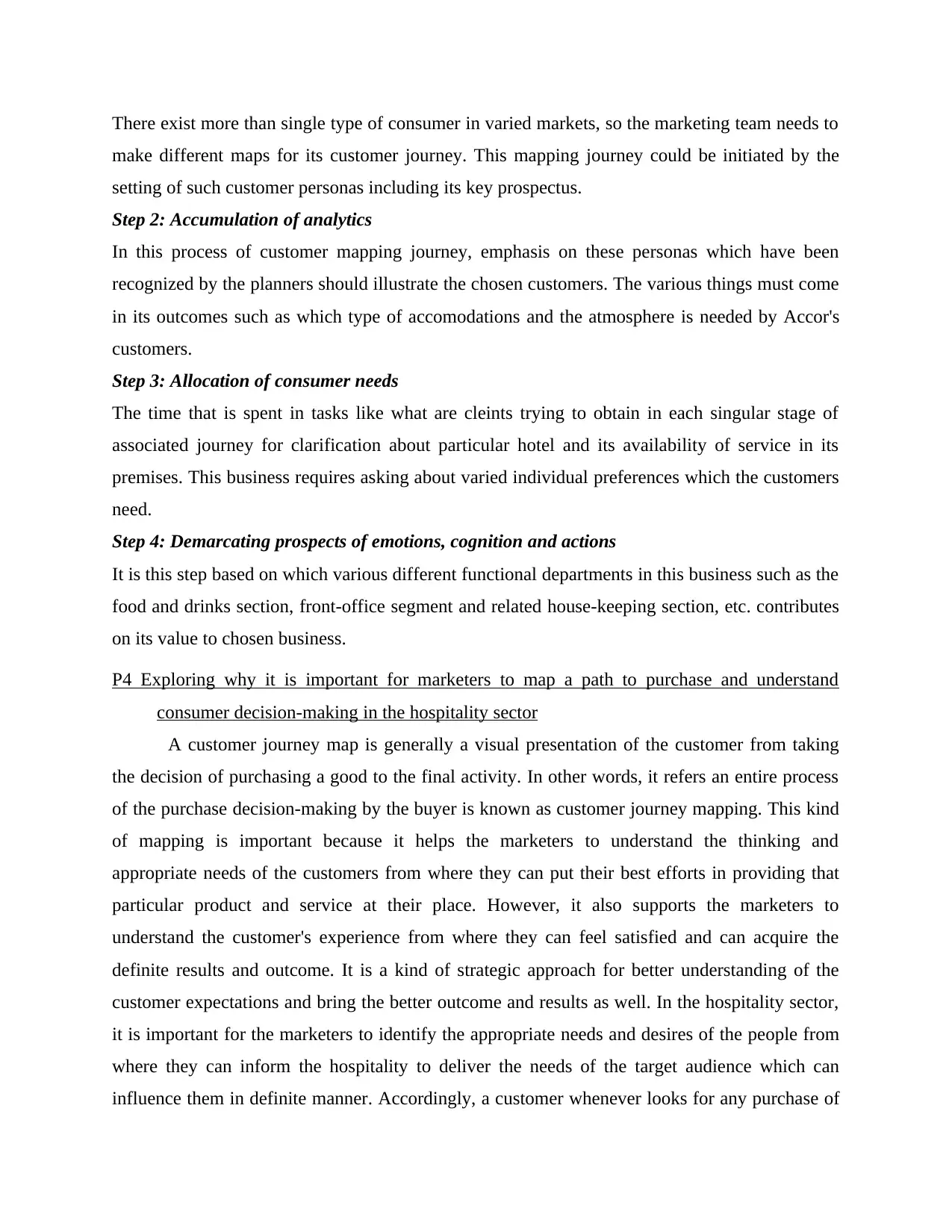
There exist more than single type of consumer in varied markets, so the marketing team needs to
make different maps for its customer journey. This mapping journey could be initiated by the
setting of such customer personas including its key prospectus.
Step 2: Accumulation of analytics
In this process of customer mapping journey, emphasis on these personas which have been
recognized by the planners should illustrate the chosen customers. The various things must come
in its outcomes such as which type of accomodations and the atmosphere is needed by Accor's
customers.
Step 3: Allocation of consumer needs
The time that is spent in tasks like what are cleints trying to obtain in each singular stage of
associated journey for clarification about particular hotel and its availability of service in its
premises. This business requires asking about varied individual preferences which the customers
need.
Step 4: Demarcating prospects of emotions, cognition and actions
It is this step based on which various different functional departments in this business such as the
food and drinks section, front-office segment and related house-keeping section, etc. contributes
on its value to chosen business.
P4 Exploring why it is important for marketers to map a path to purchase and understand
consumer decision-making in the hospitality sector
A customer journey map is generally a visual presentation of the customer from taking
the decision of purchasing a good to the final activity. In other words, it refers an entire process
of the purchase decision-making by the buyer is known as customer journey mapping. This kind
of mapping is important because it helps the marketers to understand the thinking and
appropriate needs of the customers from where they can put their best efforts in providing that
particular product and service at their place. However, it also supports the marketers to
understand the customer's experience from where they can feel satisfied and can acquire the
definite results and outcome. It is a kind of strategic approach for better understanding of the
customer expectations and bring the better outcome and results as well. In the hospitality sector,
it is important for the marketers to identify the appropriate needs and desires of the people from
where they can inform the hospitality to deliver the needs of the target audience which can
influence them in definite manner. Accordingly, a customer whenever looks for any purchase of
make different maps for its customer journey. This mapping journey could be initiated by the
setting of such customer personas including its key prospectus.
Step 2: Accumulation of analytics
In this process of customer mapping journey, emphasis on these personas which have been
recognized by the planners should illustrate the chosen customers. The various things must come
in its outcomes such as which type of accomodations and the atmosphere is needed by Accor's
customers.
Step 3: Allocation of consumer needs
The time that is spent in tasks like what are cleints trying to obtain in each singular stage of
associated journey for clarification about particular hotel and its availability of service in its
premises. This business requires asking about varied individual preferences which the customers
need.
Step 4: Demarcating prospects of emotions, cognition and actions
It is this step based on which various different functional departments in this business such as the
food and drinks section, front-office segment and related house-keeping section, etc. contributes
on its value to chosen business.
P4 Exploring why it is important for marketers to map a path to purchase and understand
consumer decision-making in the hospitality sector
A customer journey map is generally a visual presentation of the customer from taking
the decision of purchasing a good to the final activity. In other words, it refers an entire process
of the purchase decision-making by the buyer is known as customer journey mapping. This kind
of mapping is important because it helps the marketers to understand the thinking and
appropriate needs of the customers from where they can put their best efforts in providing that
particular product and service at their place. However, it also supports the marketers to
understand the customer's experience from where they can feel satisfied and can acquire the
definite results and outcome. It is a kind of strategic approach for better understanding of the
customer expectations and bring the better outcome and results as well. In the hospitality sector,
it is important for the marketers to identify the appropriate needs and desires of the people from
where they can inform the hospitality to deliver the needs of the target audience which can
influence them in definite manner. Accordingly, a customer whenever looks for any purchase of
Paraphrase This Document
Need a fresh take? Get an instant paraphrase of this document with our AI Paraphraser
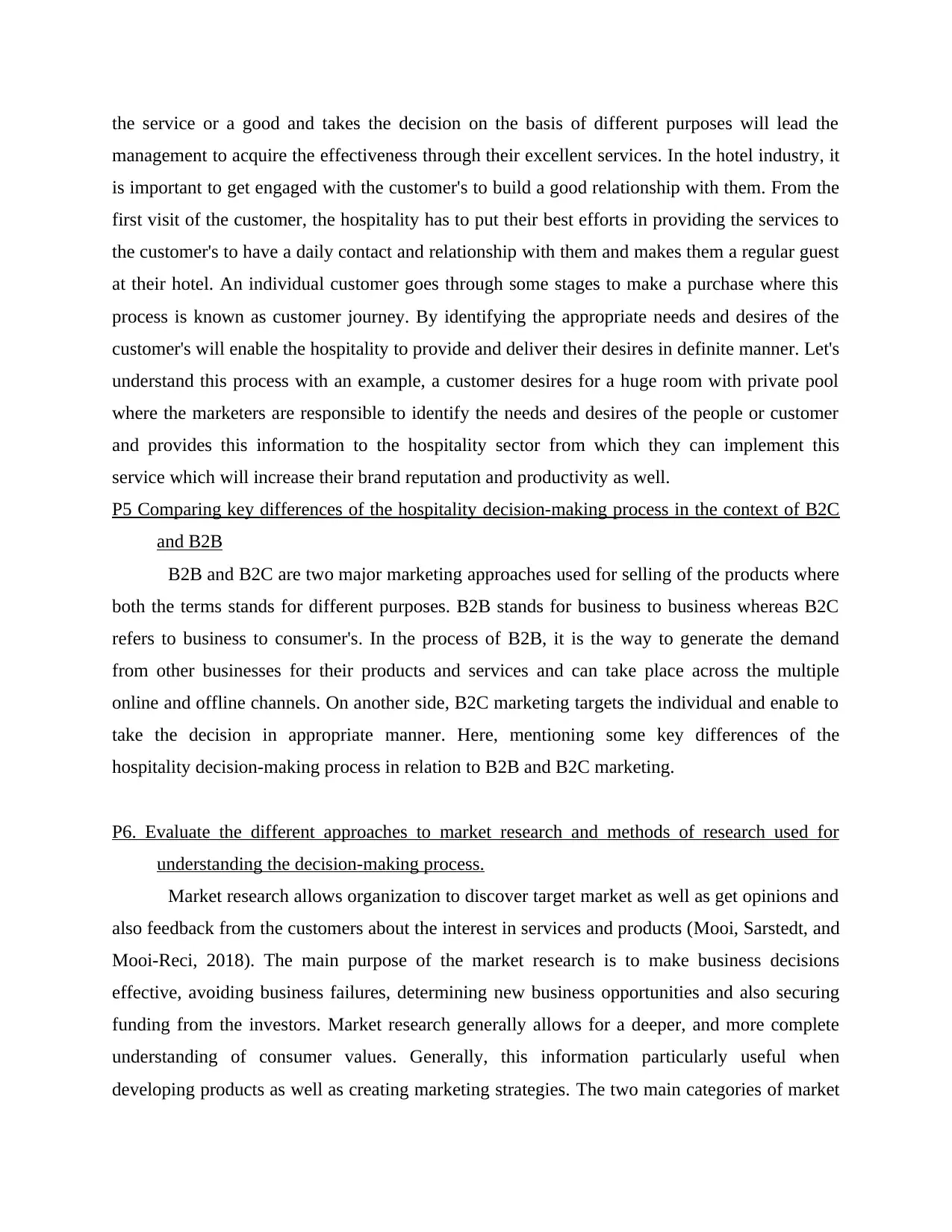
the service or a good and takes the decision on the basis of different purposes will lead the
management to acquire the effectiveness through their excellent services. In the hotel industry, it
is important to get engaged with the customer's to build a good relationship with them. From the
first visit of the customer, the hospitality has to put their best efforts in providing the services to
the customer's to have a daily contact and relationship with them and makes them a regular guest
at their hotel. An individual customer goes through some stages to make a purchase where this
process is known as customer journey. By identifying the appropriate needs and desires of the
customer's will enable the hospitality to provide and deliver their desires in definite manner. Let's
understand this process with an example, a customer desires for a huge room with private pool
where the marketers are responsible to identify the needs and desires of the people or customer
and provides this information to the hospitality sector from which they can implement this
service which will increase their brand reputation and productivity as well.
P5 Comparing key differences of the hospitality decision-making process in the context of B2C
and B2B
B2B and B2C are two major marketing approaches used for selling of the products where
both the terms stands for different purposes. B2B stands for business to business whereas B2C
refers to business to consumer's. In the process of B2B, it is the way to generate the demand
from other businesses for their products and services and can take place across the multiple
online and offline channels. On another side, B2C marketing targets the individual and enable to
take the decision in appropriate manner. Here, mentioning some key differences of the
hospitality decision-making process in relation to B2B and B2C marketing.
P6. Evaluate the different approaches to market research and methods of research used for
understanding the decision-making process.
Market research allows organization to discover target market as well as get opinions and
also feedback from the customers about the interest in services and products (Mooi, Sarstedt, and
Mooi-Reci, 2018). The main purpose of the market research is to make business decisions
effective, avoiding business failures, determining new business opportunities and also securing
funding from the investors. Market research generally allows for a deeper, and more complete
understanding of consumer values. Generally, this information particularly useful when
developing products as well as creating marketing strategies. The two main categories of market
management to acquire the effectiveness through their excellent services. In the hotel industry, it
is important to get engaged with the customer's to build a good relationship with them. From the
first visit of the customer, the hospitality has to put their best efforts in providing the services to
the customer's to have a daily contact and relationship with them and makes them a regular guest
at their hotel. An individual customer goes through some stages to make a purchase where this
process is known as customer journey. By identifying the appropriate needs and desires of the
customer's will enable the hospitality to provide and deliver their desires in definite manner. Let's
understand this process with an example, a customer desires for a huge room with private pool
where the marketers are responsible to identify the needs and desires of the people or customer
and provides this information to the hospitality sector from which they can implement this
service which will increase their brand reputation and productivity as well.
P5 Comparing key differences of the hospitality decision-making process in the context of B2C
and B2B
B2B and B2C are two major marketing approaches used for selling of the products where
both the terms stands for different purposes. B2B stands for business to business whereas B2C
refers to business to consumer's. In the process of B2B, it is the way to generate the demand
from other businesses for their products and services and can take place across the multiple
online and offline channels. On another side, B2C marketing targets the individual and enable to
take the decision in appropriate manner. Here, mentioning some key differences of the
hospitality decision-making process in relation to B2B and B2C marketing.
P6. Evaluate the different approaches to market research and methods of research used for
understanding the decision-making process.
Market research allows organization to discover target market as well as get opinions and
also feedback from the customers about the interest in services and products (Mooi, Sarstedt, and
Mooi-Reci, 2018). The main purpose of the market research is to make business decisions
effective, avoiding business failures, determining new business opportunities and also securing
funding from the investors. Market research generally allows for a deeper, and more complete
understanding of consumer values. Generally, this information particularly useful when
developing products as well as creating marketing strategies. The two main categories of market
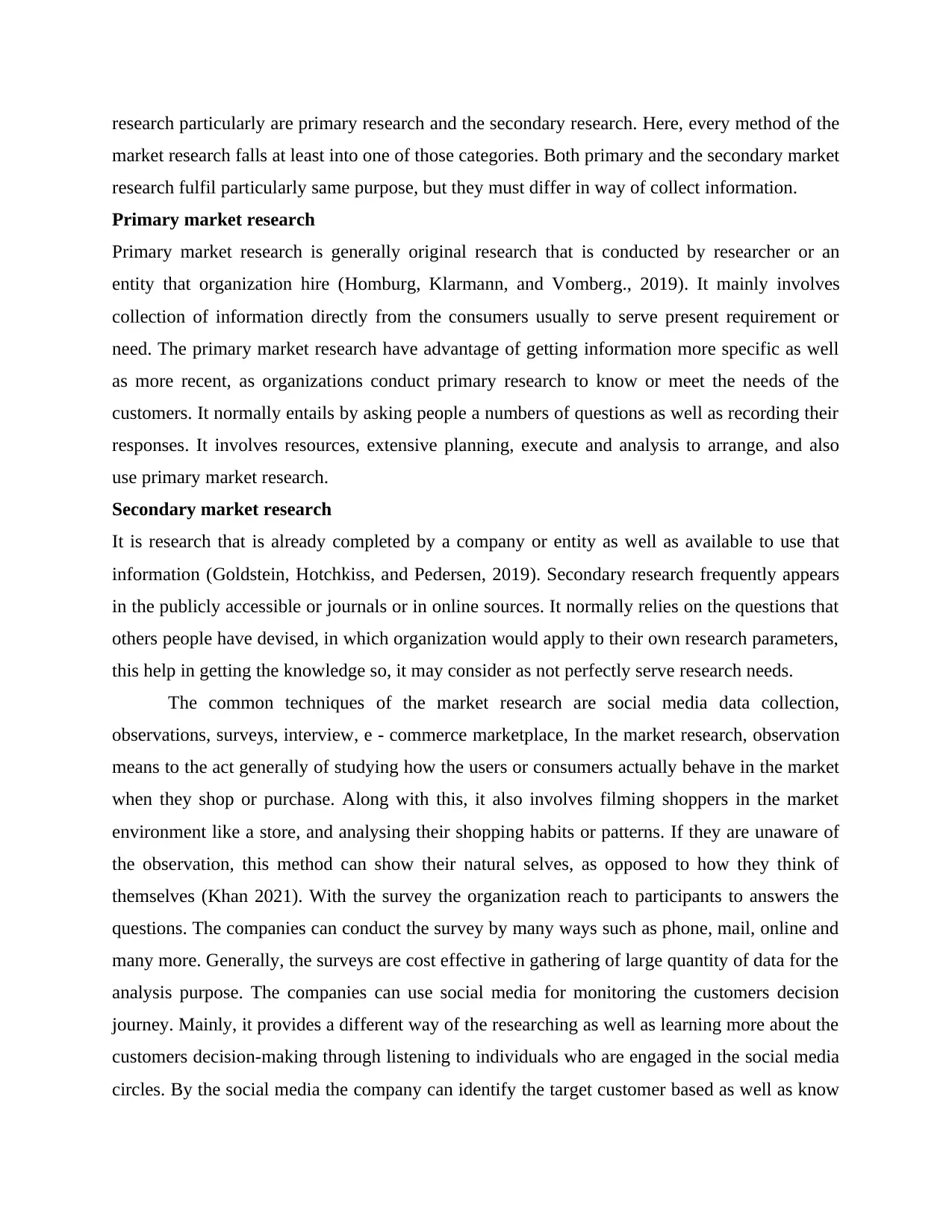
research particularly are primary research and the secondary research. Here, every method of the
market research falls at least into one of those categories. Both primary and the secondary market
research fulfil particularly same purpose, but they must differ in way of collect information.
Primary market research
Primary market research is generally original research that is conducted by researcher or an
entity that organization hire (Homburg, Klarmann, and Vomberg., 2019). It mainly involves
collection of information directly from the consumers usually to serve present requirement or
need. The primary market research have advantage of getting information more specific as well
as more recent, as organizations conduct primary research to know or meet the needs of the
customers. It normally entails by asking people a numbers of questions as well as recording their
responses. It involves resources, extensive planning, execute and analysis to arrange, and also
use primary market research.
Secondary market research
It is research that is already completed by a company or entity as well as available to use that
information (Goldstein, Hotchkiss, and Pedersen, 2019). Secondary research frequently appears
in the publicly accessible or journals or in online sources. It normally relies on the questions that
others people have devised, in which organization would apply to their own research parameters,
this help in getting the knowledge so, it may consider as not perfectly serve research needs.
The common techniques of the market research are social media data collection,
observations, surveys, interview, e - commerce marketplace, In the market research, observation
means to the act generally of studying how the users or consumers actually behave in the market
when they shop or purchase. Along with this, it also involves filming shoppers in the market
environment like a store, and analysing their shopping habits or patterns. If they are unaware of
the observation, this method can show their natural selves, as opposed to how they think of
themselves (Khan 2021). With the survey the organization reach to participants to answers the
questions. The companies can conduct the survey by many ways such as phone, mail, online and
many more. Generally, the surveys are cost effective in gathering of large quantity of data for the
analysis purpose. The companies can use social media for monitoring the customers decision
journey. Mainly, it provides a different way of the researching as well as learning more about the
customers decision-making through listening to individuals who are engaged in the social media
circles. By the social media the company can identify the target customer based as well as know
market research falls at least into one of those categories. Both primary and the secondary market
research fulfil particularly same purpose, but they must differ in way of collect information.
Primary market research
Primary market research is generally original research that is conducted by researcher or an
entity that organization hire (Homburg, Klarmann, and Vomberg., 2019). It mainly involves
collection of information directly from the consumers usually to serve present requirement or
need. The primary market research have advantage of getting information more specific as well
as more recent, as organizations conduct primary research to know or meet the needs of the
customers. It normally entails by asking people a numbers of questions as well as recording their
responses. It involves resources, extensive planning, execute and analysis to arrange, and also
use primary market research.
Secondary market research
It is research that is already completed by a company or entity as well as available to use that
information (Goldstein, Hotchkiss, and Pedersen, 2019). Secondary research frequently appears
in the publicly accessible or journals or in online sources. It normally relies on the questions that
others people have devised, in which organization would apply to their own research parameters,
this help in getting the knowledge so, it may consider as not perfectly serve research needs.
The common techniques of the market research are social media data collection,
observations, surveys, interview, e - commerce marketplace, In the market research, observation
means to the act generally of studying how the users or consumers actually behave in the market
when they shop or purchase. Along with this, it also involves filming shoppers in the market
environment like a store, and analysing their shopping habits or patterns. If they are unaware of
the observation, this method can show their natural selves, as opposed to how they think of
themselves (Khan 2021). With the survey the organization reach to participants to answers the
questions. The companies can conduct the survey by many ways such as phone, mail, online and
many more. Generally, the surveys are cost effective in gathering of large quantity of data for the
analysis purpose. The companies can use social media for monitoring the customers decision
journey. Mainly, it provides a different way of the researching as well as learning more about the
customers decision-making through listening to individuals who are engaged in the social media
circles. By the social media the company can identify the target customer based as well as know
⊘ This is a preview!⊘
Do you want full access?
Subscribe today to unlock all pages.

Trusted by 1+ million students worldwide
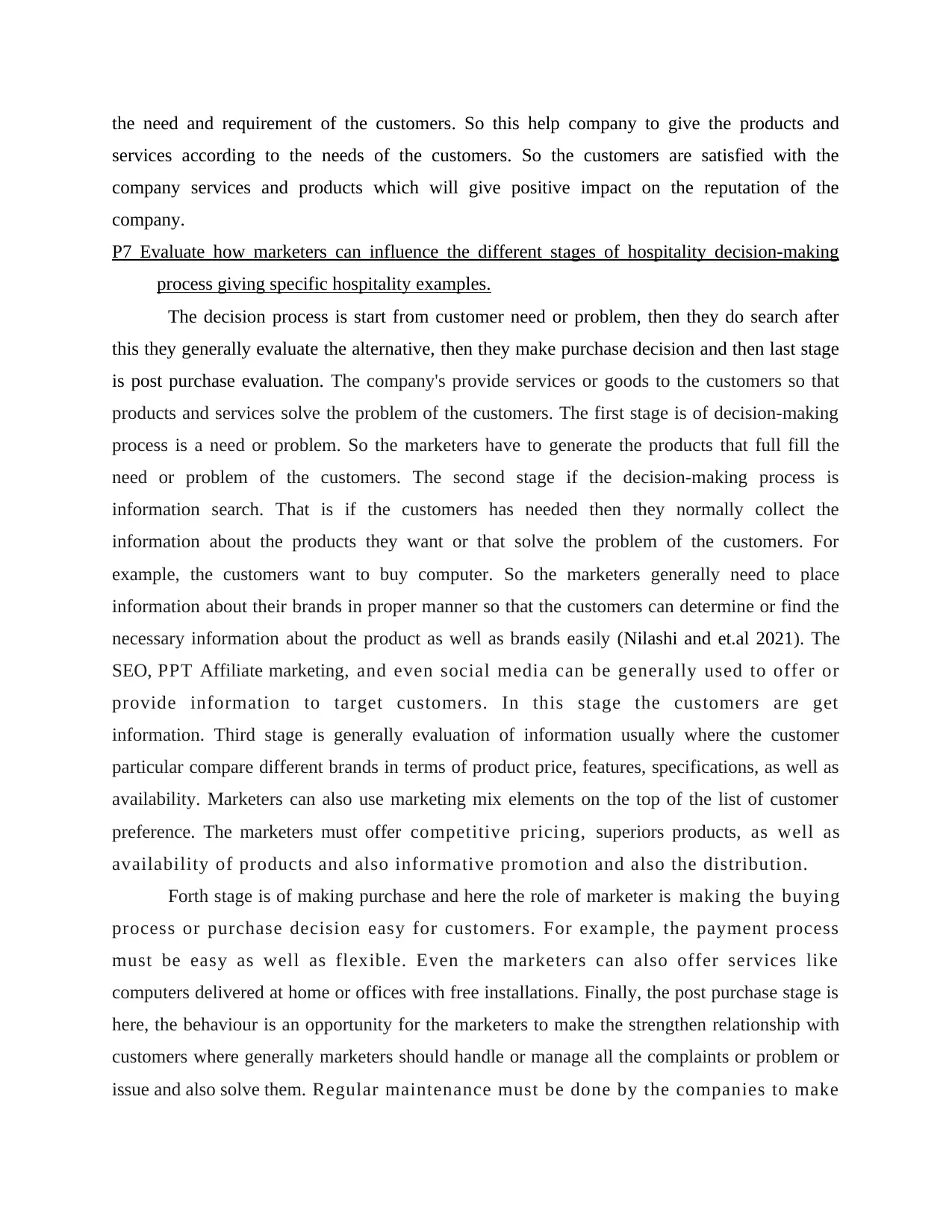
the need and requirement of the customers. So this help company to give the products and
services according to the needs of the customers. So the customers are satisfied with the
company services and products which will give positive impact on the reputation of the
company.
P7 Evaluate how marketers can influence the different stages of hospitality decision-making
process giving specific hospitality examples.
The decision process is start from customer need or problem, then they do search after
this they generally evaluate the alternative, then they make purchase decision and then last stage
is post purchase evaluation. The company's provide services or goods to the customers so that
products and services solve the problem of the customers. The first stage is of decision-making
process is a need or problem. So the marketers have to generate the products that full fill the
need or problem of the customers. The second stage if the decision-making process is
information search. That is if the customers has needed then they normally collect the
information about the products they want or that solve the problem of the customers. For
example, the customers want to buy computer. So the marketers generally need to place
information about their brands in proper manner so that the customers can determine or find the
necessary information about the product as well as brands easily (Nilashi and et.al 2021). The
SEO, PPT Affiliate marketing, and even social media can be generally used to offer or
provide information to target customers. In this stage the customers are get
information. Third stage is generally evaluation of information usually where the customer
particular compare different brands in terms of product price, features, specifications, as well as
availability. Marketers can also use marketing mix elements on the top of the list of customer
preference. The marketers must offer competitive pricing, superiors products, as well as
availability of products and also informative promotion and also the distribution.
Forth stage is of making purchase and here the role of marketer is making the buying
process or purchase decision easy for customers. For example, the payment process
must be easy as well as flexible. Even the marketers can also offer services like
computers delivered at home or offices with free installations. Finally, the post purchase stage is
here, the behaviour is an opportunity for the marketers to make the strengthen relationship with
customers where generally marketers should handle or manage all the complaints or problem or
issue and also solve them. Regular maintenance must be done by the companies to make
services according to the needs of the customers. So the customers are satisfied with the
company services and products which will give positive impact on the reputation of the
company.
P7 Evaluate how marketers can influence the different stages of hospitality decision-making
process giving specific hospitality examples.
The decision process is start from customer need or problem, then they do search after
this they generally evaluate the alternative, then they make purchase decision and then last stage
is post purchase evaluation. The company's provide services or goods to the customers so that
products and services solve the problem of the customers. The first stage is of decision-making
process is a need or problem. So the marketers have to generate the products that full fill the
need or problem of the customers. The second stage if the decision-making process is
information search. That is if the customers has needed then they normally collect the
information about the products they want or that solve the problem of the customers. For
example, the customers want to buy computer. So the marketers generally need to place
information about their brands in proper manner so that the customers can determine or find the
necessary information about the product as well as brands easily (Nilashi and et.al 2021). The
SEO, PPT Affiliate marketing, and even social media can be generally used to offer or
provide information to target customers. In this stage the customers are get
information. Third stage is generally evaluation of information usually where the customer
particular compare different brands in terms of product price, features, specifications, as well as
availability. Marketers can also use marketing mix elements on the top of the list of customer
preference. The marketers must offer competitive pricing, superiors products, as well as
availability of products and also informative promotion and also the distribution.
Forth stage is of making purchase and here the role of marketer is making the buying
process or purchase decision easy for customers. For example, the payment process
must be easy as well as flexible. Even the marketers can also offer services like
computers delivered at home or offices with free installations. Finally, the post purchase stage is
here, the behaviour is an opportunity for the marketers to make the strengthen relationship with
customers where generally marketers should handle or manage all the complaints or problem or
issue and also solve them. Regular maintenance must be done by the companies to make
Paraphrase This Document
Need a fresh take? Get an instant paraphrase of this document with our AI Paraphraser
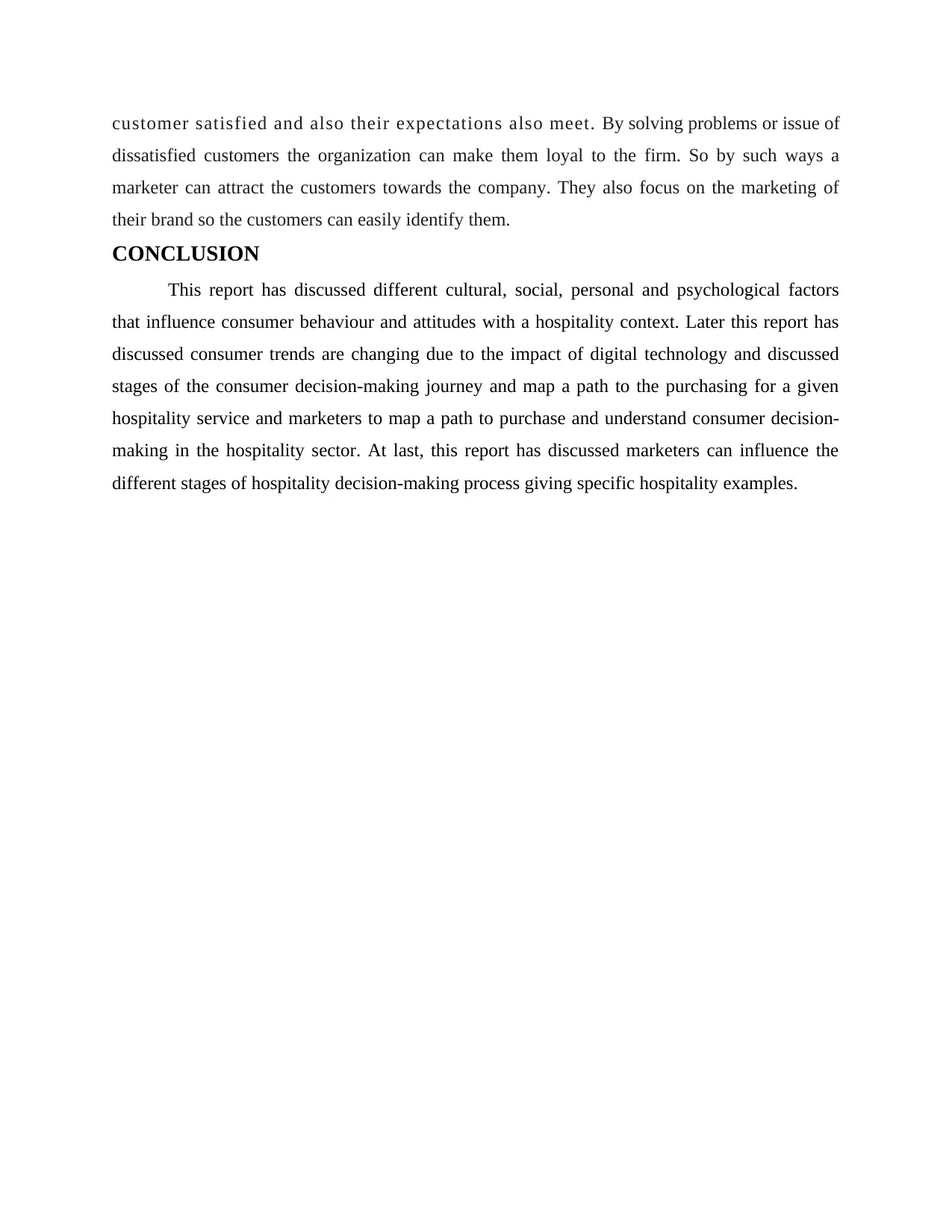
customer satisfied and also their expectations also meet. By solving problems or issue of
dissatisfied customers the organization can make them loyal to the firm. So by such ways a
marketer can attract the customers towards the company. They also focus on the marketing of
their brand so the customers can easily identify them.
CONCLUSION
This report has discussed different cultural, social, personal and psychological factors
that influence consumer behaviour and attitudes with a hospitality context. Later this report has
discussed consumer trends are changing due to the impact of digital technology and discussed
stages of the consumer decision-making journey and map a path to the purchasing for a given
hospitality service and marketers to map a path to purchase and understand consumer decision-
making in the hospitality sector. At last, this report has discussed marketers can influence the
different stages of hospitality decision-making process giving specific hospitality examples.
dissatisfied customers the organization can make them loyal to the firm. So by such ways a
marketer can attract the customers towards the company. They also focus on the marketing of
their brand so the customers can easily identify them.
CONCLUSION
This report has discussed different cultural, social, personal and psychological factors
that influence consumer behaviour and attitudes with a hospitality context. Later this report has
discussed consumer trends are changing due to the impact of digital technology and discussed
stages of the consumer decision-making journey and map a path to the purchasing for a given
hospitality service and marketers to map a path to purchase and understand consumer decision-
making in the hospitality sector. At last, this report has discussed marketers can influence the
different stages of hospitality decision-making process giving specific hospitality examples.
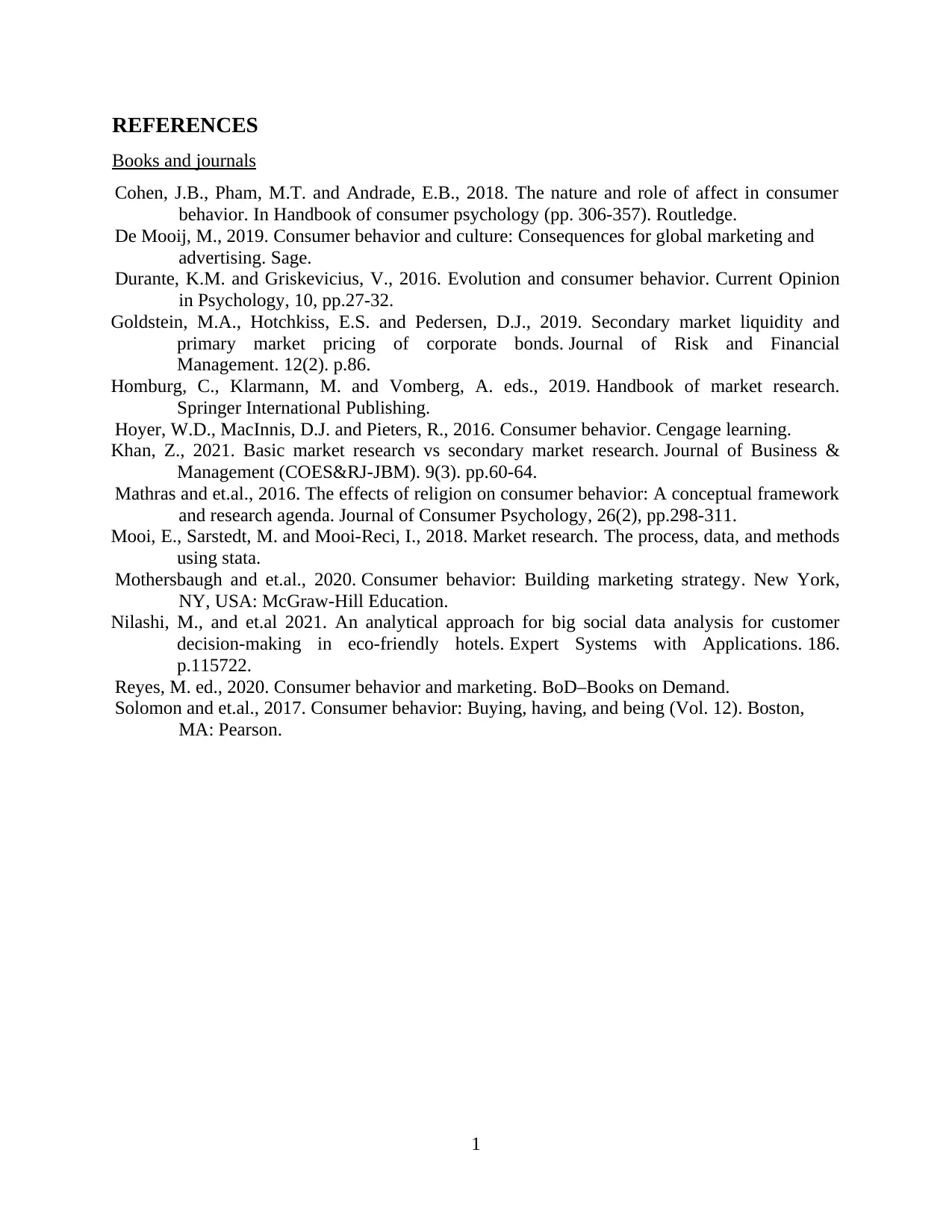
REFERENCES
Books and journals
Cohen, J.B., Pham, M.T. and Andrade, E.B., 2018. The nature and role of affect in consumer
behavior. In Handbook of consumer psychology (pp. 306-357). Routledge.
De Mooij, M., 2019. Consumer behavior and culture: Consequences for global marketing and
advertising. Sage.
Durante, K.M. and Griskevicius, V., 2016. Evolution and consumer behavior. Current Opinion
in Psychology, 10, pp.27-32.
Goldstein, M.A., Hotchkiss, E.S. and Pedersen, D.J., 2019. Secondary market liquidity and
primary market pricing of corporate bonds. Journal of Risk and Financial
Management. 12(2). p.86.
Homburg, C., Klarmann, M. and Vomberg, A. eds., 2019. Handbook of market research.
Springer International Publishing.
Hoyer, W.D., MacInnis, D.J. and Pieters, R., 2016. Consumer behavior. Cengage learning.
Khan, Z., 2021. Basic market research vs secondary market research. Journal of Business &
Management (COES&RJ-JBM). 9(3). pp.60-64.
Mathras and et.al., 2016. The effects of religion on consumer behavior: A conceptual framework
and research agenda. Journal of Consumer Psychology, 26(2), pp.298-311.
Mooi, E., Sarstedt, M. and Mooi-Reci, I., 2018. Market research. The process, data, and methods
using stata.
Mothersbaugh and et.al., 2020. Consumer behavior: Building marketing strategy. New York,
NY, USA: McGraw-Hill Education.
Nilashi, M., and et.al 2021. An analytical approach for big social data analysis for customer
decision-making in eco-friendly hotels. Expert Systems with Applications. 186.
p.115722.
Reyes, M. ed., 2020. Consumer behavior and marketing. BoD–Books on Demand.
Solomon and et.al., 2017. Consumer behavior: Buying, having, and being (Vol. 12). Boston,
MA: Pearson.
1
Books and journals
Cohen, J.B., Pham, M.T. and Andrade, E.B., 2018. The nature and role of affect in consumer
behavior. In Handbook of consumer psychology (pp. 306-357). Routledge.
De Mooij, M., 2019. Consumer behavior and culture: Consequences for global marketing and
advertising. Sage.
Durante, K.M. and Griskevicius, V., 2016. Evolution and consumer behavior. Current Opinion
in Psychology, 10, pp.27-32.
Goldstein, M.A., Hotchkiss, E.S. and Pedersen, D.J., 2019. Secondary market liquidity and
primary market pricing of corporate bonds. Journal of Risk and Financial
Management. 12(2). p.86.
Homburg, C., Klarmann, M. and Vomberg, A. eds., 2019. Handbook of market research.
Springer International Publishing.
Hoyer, W.D., MacInnis, D.J. and Pieters, R., 2016. Consumer behavior. Cengage learning.
Khan, Z., 2021. Basic market research vs secondary market research. Journal of Business &
Management (COES&RJ-JBM). 9(3). pp.60-64.
Mathras and et.al., 2016. The effects of religion on consumer behavior: A conceptual framework
and research agenda. Journal of Consumer Psychology, 26(2), pp.298-311.
Mooi, E., Sarstedt, M. and Mooi-Reci, I., 2018. Market research. The process, data, and methods
using stata.
Mothersbaugh and et.al., 2020. Consumer behavior: Building marketing strategy. New York,
NY, USA: McGraw-Hill Education.
Nilashi, M., and et.al 2021. An analytical approach for big social data analysis for customer
decision-making in eco-friendly hotels. Expert Systems with Applications. 186.
p.115722.
Reyes, M. ed., 2020. Consumer behavior and marketing. BoD–Books on Demand.
Solomon and et.al., 2017. Consumer behavior: Buying, having, and being (Vol. 12). Boston,
MA: Pearson.
1
⊘ This is a preview!⊘
Do you want full access?
Subscribe today to unlock all pages.

Trusted by 1+ million students worldwide
1 out of 12
Related Documents
Your All-in-One AI-Powered Toolkit for Academic Success.
+13062052269
info@desklib.com
Available 24*7 on WhatsApp / Email
![[object Object]](/_next/static/media/star-bottom.7253800d.svg)
Unlock your academic potential
Copyright © 2020–2025 A2Z Services. All Rights Reserved. Developed and managed by ZUCOL.


